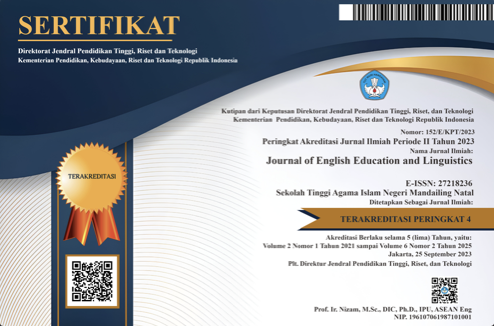THE COMPLEX SENTENCE ACQUISITION BY FIVE YEARS OLD KINDERGARTEN STUDENTS
DOI:
https://doi.org/10.56874/jeel.v1i1.55Keywords:
Language acquisition, Complex Sentences , Language acquisition of 5 years old Children, Social Interaction Kindergarten Students.Abstract
This research deals with language acquisition. It aims to describe what types of complex sentences are produced by five years old Kindergarten students in their social interaction. The methodology of this research uses Qualitative Research where the researcher involved six kindergarten students of five years old in RA Fatayat Nahdhatul Ulama Batahan as data sources. The data of this research was obtained by using the naturalistic method by observing, making a conversation, recording, and taking notes. The result found that the Five years old kindergarten students already produced a noun clause, relative clause, and adverbial clause as subordinate clause or dependent clause to modify or give more explanation about the main clause or independent clause to produce complex sentences. And they also used a coordinating conjunction and subordinating conjunction to join the dependent clause to the independent clause, or they just used an intonation to separate between dependent clause from independent clause.
References
Akhtar, N., Carpenter, M., & Tomasello, M. 1996. The role of discourse novelty in early word learning.Journal ofChild Development. 67: 635-645.
Ann, Benjamin L.Parents’ Literacy and their Children’s Success in School: RecentResearch, Promising Practices, and Research Implications. Education Research Report, 1993
Arizona (2006) The Acquisition Of Sentences By Three Years Old Children, Thesis: State University of Medan
Azar, Betty Schrampfer. 1992. Fundamental of English Grammar, New Jersey, Prentice Hall
Barrett, M. (ed.) 1999. The Development of Language. Hove: Psychology Press.
Berman, R. (2009). Language development in narrative contexts. In E.L. Bavin (Ed.) The Cambridge handbook of child language (pp. 355-375). Cambridge: Cambridge University Press.
Bogdan, R. C.,& Bigden, S. K. 1992. Qualitative Research for Education. An Introduction to Theory and Methods.Syracuse University: Allyn and Bacon Spradley (1980:54)
Brown, H. D. (2000). Principles of language learning and teaching. New York: Longman.
Brown. H. Douglas, Principle of Language Learning and Teaching. San Fransisco: State University 1977
Carr, L., & Johnston, J. 2001. Morphological cues to verb meaning. Applied Psycholinguistics, 22, 601-618
Chomsky, Noam, 1965, Aspects of the Theory of Syntax, MIT Press
Clark, E.V. 2003. First Language Acquisition for Education, An Introduction to
Theory and Methods, Second Edition.
Dardjowidjojo, S. 2000. ECHA: Kisah Pemerolehan Bahasa Anak Indonesia,Jakarta.
PT. Grasindo Jaya
Ferguson, C. A. & Snow, C. E. (Eds). (1977). Talking to children. Language input
and acquisition. Great Britain: Cambridge University Press.
Glickman, Carl. Letters to the Next President: What We Can Do about the Real Crisis
in Public Education. New York: Teachers College Press, 2004.
Halliday, M.A.K. and Matthiessen, C.M.I.M. 2004. An Introduction to Functional Grammar. Arnold: p6.
Hart, B., & Risley, T. R. 1995. Meaningful differences in the everyday experience of young American children. Baltimore, MD: P. H. Brookes.
Maesarah, Ananda, 2012.Sentences Acquisition By Three Years Old Boys And Girls. Thesis: State University of Medan
Sariman, Indra (2014), Acquisition Of Clause Complexes By Indonesian Kindergarten Students With Different Mothers’ Social Class. Thesis: State Universtiy of Medan
Vygotsky, L. S. 1978. Mind in society: The development of higher psychological processes. Cambridge: Harvard University Press
Webster New World Colledge Dictionary, 1996. Macmillan Simon & Schuster, Inc.
Downloads
Published
Issue
Section
License
All articles published in the Journal of English Education and Linguistics are licensed under a Creative Commons Attribution-ShareAlike 4.0 International (CC BY-SA) license. This means anyone is free to copy, transform, or redistribute articles for any lawful purpose in any medium, provided they give appropriate attribution to the original author(s) and Journal of English Education and Linguistics, link to the license, indicate if changes were made, and redistribute any derivative work under the same license.
Copyright on articles is retained by the respective author(s) without restrictions. A non-exclusive license is granted to the Journal of English Education and Linguistics to publish the article and identify itself as its original publisher, along with the commercial right to include the article in a hardcopy issue for sale to libraries and individuals.
Although the conditions of the Creative Commons Attribution-ShareAlike 4.0 International (CC BY-SA) license do not apply to authors (as the copyright holder of your article, you have no restrictions on your rights), by submitting to the Journal of English Education and Linguistics, authors recognize the rights of readers and must grant any third party the right to use their articles to the extent provided by the license.

This work is licensed under a Creative Commons Attribution-ShareAlike 4.0 International License.








